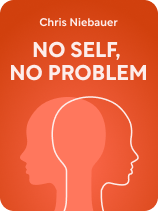

This article is an excerpt from the Shortform book guide to "No Self, No Problem" by Chris Niebauer. Shortform has the world's best summaries and analyses of books you should be reading.
Like this article? Sign up for a free trial here.
Is there more to you than your thoughts and actions? What if the self you’ve always known isn’t as real as you think?
In No Self, No Problem, Chris Niebauer challenges the understanding of the self in Western thought. He explores how our beliefs about identity, consciousness, and free will might be based on illusions. This book offers a fresh perspective on what it means to be human.
Keep reading to discover why your sense of self might be more fluid than you ever imagined.
The Self in Western Thought
Niebauer’s examination of the self in Western thought reveals some foundational assumptions: People raised in the West learn that the self is real, it’s continuous over time, and it’s the “doer” behind our thoughts, feelings, decisions, and actions. In the West, thinking is considered a central part of the self. Niebauer says most people in the West implicitly assume that the self is the part of the mind engaged in explaining our experiences and narrating our thoughts. For centuries, Western philosophy has linked the act of thinking to our very being: We know we exist precisely because we can think (and notice ourselves thinking). This means that in the West, having a self who thinks, judges, and decides is considered a vital part of being human.
(Shortform note: An influential contributor to the idea of the thinking self is philosopher René Descartes, whose famous proclamation, “I think, therefore I am,” Niebauer cites. Descartes saw the self as the entity behind your thoughts. He also proposed mind-body dualism: the idea that the mind, or thinking self, is distinct from the body, or material self. Neuroscience calls this idea into question by suggesting that everything that happens in your mind corresponds with something happening in your brain. Some experts say this is evidence for materialism, a theory that the mind is just a product of the brain. Others say it fits better with hylomorphism: a theory that the body and mind are a person’s “matter” and “form,” and can’t exist without each other.)
Along with the idea of the thinking self goes the idea that the self also persists, seemingly unchanged, over time. Niebauer points out that you perceive yourself as the same person day in and day out, with a consistent set of values and inclinations and a distinct personality. In other words, you feel you’re the same person today as you were yesterday—and the day before that, and the day before that. (Shortform note: Psychologist Susan Blackmore (The Meme Machine) says the continuity of the self is illusory: something we invent just by looking for it, when we connect the dots between our experiences. She says the illusion of the self isn’t so much that it doesn’t exist but that it’s not the stable entity it seems.)
(Shortform note: Our brains find a way to maintain a stable sense of self even under unusual circumstances. This is illustrated surprisingly accurately by the 2003 film Finding Nemo, where a fish named Dory has anterograde amnesia and can’t form new memories—but never loses her sense of a consistent self. Scientists explain that people with anterograde amnesia can’t depend on conscious memory for their sense of self. Instead, they use their whole body to tap into the dispositions and tendencies that make up their unique “existential style.” Even without memory, they maintain a strong sense of self by accessing this embodied knowledge about who they are—just as Dory maintains her optimism and her determination to “just keep swimming.”)
Throughout the book, Niebauer contends that the Western sense of the self as real is deceptive—but he acknowledges it’s hard to fathom the idea of existing without a self. That’s in part because your sense of self feels inextricably linked to your sense of agency, and it seems to drive your decisions. Because of your perception that the self is in the driver’s seat and doing the navigating, you can think about drinking your morning espresso or writing a report at work and feel certain it’s “you” who did those things. (If not you, then who was it?)
(Shortform note: Psychologist Bruce Hood agrees with Niebauer that while we experience a sense of self, that self doesn’t exist outside our perception of it. In The Self Illusion, Hood advises thinking of your “self” as two parts: an “I” conscious in the present moment and a “me” aware of your past and your plans for the future, an idea first proposed by philosopher William James. Hood theorizes your brain treats the “I” and “me” as if they were real. But they’re just an illusion the brain creates so you can make sense of the unconscious mechanisms and processes behind your behavior. In other words, your “self” doesn’t drive your decisions: Your brain just hallucinates your sense of self to explain the processes that do.)

———End of Preview———
Like what you just read? Read the rest of the world's best book summary and analysis of Chris Niebauer's "No Self, No Problem" at Shortform.
Here's what you'll find in our full No Self, No Problem summary:
- Why everything you know about yourself is wrong
- How science is catching on to what Eastern religions have been teaching for millenia
- How to loosen your grip on the thoughts and judgments that make you dissatisfied with your reality






